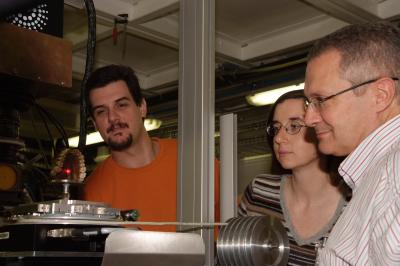- Home
- News
- General News
- ESRF reveals human...
ESRF reveals human children outpaced Neanderthals by slowing down
16-11-2010
PRESS RELEASE - Human childhood is considerably longer than chimpanzees', our closest-living ape relatives. A multinational team of specialists, led by researchers from Harvard University, Max-Planck Institute for Evolutionary Anthropology (MPI-EVA) and the ESRF applied cutting-edge synchrotron X-ray imaging to resolve microscopic growth in 10 young Neanderthal and Homo sapiens fossils. They found that significant developmental differences exist despite some overlap, which is common in closely-related species. Modern humans are the slowest to the finish line, stretching out their maturation, which may have given them a unique evolutionary advantage.
Share
Evolutionary biology has shown that small changes during early development may lead to differences that result in new species. These changes may take the form of modifications in the sequence or timing of developmental events; therefore, understanding developmental transformation is key to reconstructing evolutionary history. Anthropologists have documented many differences in adult characteristics among closely related species, such as humans and chimpanzees. Genomic data combined with fossil evidence indicate that these two lineages split six to seven million years ago, and have since been evolving separately. However, we know much less about which changes led to the separate lineages, how these changes arose, and when they occurred.
One poorly understood change is our unique life history, or the way in which we time growth, development, and reproductive efforts. Compared to humans, non-human primate life history is marked by a shorter gestation period, faster post-natal maturation rates, younger age at first reproduction, shorter post-reproductive period, and a shorter overall lifespan. For example, chimpanzees reach reproductive maturity several years before humans, bearing their first offspring by age 13, in contrast to the human average of 19.
It might seem that life history is invisible in the fossil record, but it turns out that many life history variables correlate strongly with dental development. “Teeth are remarkable time recorders, capturing each day of growth much like rings in trees reveal yearly progress. Even more impressive is the fact that our first molars contain a tiny ‘birth certificate,’ and finding this birth line allows us to calculate exactly how old a juvenile was when it died” says Tanya Smith, researcher at Harvard University and MPI-EVA.
 |
|
|
State-of-the-art synchrotron imaging of the tiny upper jaw (maxilla) of the Engis 2 Neanderthal allows scientists to virtually isolate the permanent teeth inside the bone (center image), count tiny growth lines inside the first molar teeth (lower image), and determine that it died at age 3. Fossil courtesy of the Université de Liège. Photo credits Graham Chedd (PBS), Paul Tafforeau (ESRF), and Tanya Smith (Harvard University and MPI-EVA). |
This forensic approach to the past is possible with a ‘super-microscope:’ extremely powerful X-ray beams produced at the European Synchrotron Radiation Facility (ESRF) in Grenoble, France, which is one of the largest synchrotron in the world. Paul Tafforeau, from the ESRF, notes: “At the ESRF, we are able to look inside invaluable fossils without damaging them by using the special properties of high energy synchrotron X-rays. We can investigate fossils at different scales and in three-dimensions, ranging from studies of overall 3D shape down to microscopic daily growth lines. This is currently the only place where these studies of fossil humans are possible.” Scientists and curators have been quietly visiting the European synchrotron, often with some of the rarest hominin fossils in the world, for imaging with this state-of-the-art technique.
The study includes some of the most famous Neanderthal children, including the first hominin fossil ever discovered. This Belgian Neanderthal child, discovered in the winter of 1829-1830, was thought to be 4-5 years of age when it died. Powerful synchrotron X-rays and cutting-edge imaging software revealed that it actually died at a mere 3 years of age. Another invaluable Neanderthal discovered in Le Moustier, France in 1908, barely survived the shelling of its’ German repository during the Second World War.
 |
Scientists Paul Tafforeau (ESRF), Tanya Smith (Harvard University & MPI-EVA), and Jean-Jacques Hublin (MPI-EVA) position the upper jaw (maxilla) of the Le Moustier 1 juvenile Neanderthal before passing powerful X-rays through the fossil to see inside its’ teeth. Modern human developmental models suggested that this individual would have been 15-16 years of age, while the current study demonstrates that this 11.6-12.1 year old individual matured more rapidly than modern humans. Fossil courtesy of the Museum fur Vor- und Frühgeschichte (Berlin). Photo credit Chantal Argoud (ESRF).
A remarkable finding of this five-year study is that Neanderthals grow their teeth significantly faster than members of our own species, including some of the earliest groups of modern humans to leave Africa between 90-100,000 years ago. The Neanderthal pattern appears to be intermediate between early members of our genus (e.g., Homo erectus) and living people, suggesting that the characteristically slow development and long childhood is a recent condition unique to our own species. This extended period of maturation may facilitate additional learning and complex cognition, possibly giving early Homo sapiens a competitive advantage over their contemporaneous Neanderthal cousins.
These new results present a unique opportunity to assess the origins of a fundamentally human condition: the costly yet advantageous shift from a primitive “live fast and die young” strategy to the “live slow and grow old” strategy that has helped to make us one of the most successful organisms on the planet.
Reference:
Smith, T.M., Tafforeau, P., Reid, D.J., Pouech, J., Lazzari, V., Zermeno, J.P., Guatelli-Steinberg, D., Olejniczak, A.J., Hoffman, A., Radovčić, J., Masrour, M., Toussaint, M., Stringer, C., Hublin, J-J., Dental evidence for ontogenetic differences between modern humans and Neanderthals. Proc. Natl. Acad. Sci. USA. 107, 20923-20928 (2010).
For videos and more images, please have a look at http://www.heb.fas.harvard.edu/Press



